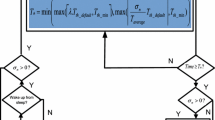Abstract
For reducing the energy consumption of the Mobile Station in mobile Broadband Wireless Access networks, IEEE 802.16 offers three kinds of sleep mode operations called power saving classes type I, type II and type III. In order to investigate mathematically the inherent relationships between the performance measures and the system parameters, we propose in this paper a novel method for modeling the sleep mode with the power saving class type II in IEEE 802.16 and analyzing the performance of this sleep mode. Considering the attractive feature that some data frames can be transmitted during the listening state, we present a queueing model with two kinds of busy mechanisms to capture the working principle of the sleep mode operations with the power saving class type II. With the first and higher derivatives of the probability generating functions, we can give the averages and the standard deviations for the system performance using the diffusion approximation for the operating process of the system. We also propose methods for measuring the system performance in terms of the switching ratio, the energy saving ratio, and the average response time of data frames, as well as giving the expressions for these performance measures. Numerical results are provided with analysis and simulation to show the average performance measures, standard deviations and the cost function with different system loads. Moreover, we construct a cost function with the aim of determining the optimal time length of the sleep window to minimize the cost function.
Similar content being viewed by others
References
Chen T., Chen J.: Extended maximizing unavailability interval (eMUI): maximizing energy saving in IEEE 802.16e for mixing Type I and Type II PSCs. IEEE Commun. Lett. 13(2), 151–153 (2009)
Chen T., Chen J., Chen Y.: Maximizing unavailability interval for energy saving in IEEE 802.16e wireless MANs. IEEE Trans. Mob. Comput. 8(4), 465–487 (2009)
Han, K., Choi, S.: Performance analysis of sleep mode operation in IEEE 802.16e mobile broadband wireless access systems. In: Proceedings of the Vehicular Technology Conference, pp. 1141–1145 (2006)
Hwang E., Kim K., Son J., Choi D.: The power saving mechanism with binary exponential traffic indications in the IEEE 802.16e/m. Queueing Syst. 62(3), 197–227 (2009)
IEEE 802.16-2009: IEEE Standard for Local and Metropolitan Area Networks, Part 16: Air Interface for Fixed and Mobile Broadband Wireless Access Systems, IEEE Standards Association (2009)
Jin S., Yue W.: Performance analysis for power saving class type III of IEEE 802.16 in WiMAX. Comput. Netw. 55(16), 3734–3743 (2011)
Khaitan S., McCalley J., Raju M.: Numerical methods for on-line power system load flow analysis. Energy Syst. 1(3), 273–289 (2010)
Knopov P., Pardalos P.: Simulation and Optimization Methods in Risk and Reliability Theory. Nova Science Publishers, New York (2009)
Kong, L., Tsang, D.H.: Performance study of power saving classes of Types I and II in IEEE 802.16e. In: Proceedings of the 31st IEEE Conference on Local Computer Networks, pp. 20–27 (2006)
Lee, B., Lee, H., Rhee, S., et al.: Cumulative-TIM method for the sleep mode in IEEE 802.16e wireless. In: Proceedings of the International Conference on Information Networking, pp. 502–511 (2006)
Lee J., Cho D.: An optimal power-saving class II for VoIP traffic and its performance evaluations in IEEE 802.16e. Comput. Commun. 31(14), 3204–3208 (2008)
Min M., Pardalos P.: Total energy optimal multicasting in wireless ad hoc networks. J. Comb. Optim. 13(4), 365–378 (2007)
Resende M., Pardalos P.: Handbook of Optimization in Telecommunications. Springer, Berlin (2006)
Tian N., Zhang G.: Vacation Queueing Models—Theory and Applications. Springer, Dordrecht (2006)
Tseng Y., Chen J., Yang Y.: Managing power saving classes in IEEE 802.16 wireless MANs: a fold-and-demultiplex method. IEEE Trans. Mob. Comput. 10(9), 1237–1247 (2011)
Wu W., Gao X., Pardalos P., Du D.: Wireless networking, dominating and packing. Optim. Lett. 4(3), 347–358 (2010)
Xiao Y.: Energy saving mechanism in the IEEE 802.16e wireless MAN. IEEE Commun. Lett. 9(7), 595–597 (2005)
Author information
Authors and Affiliations
Corresponding author
Rights and permissions
About this article
Cite this article
Jin, S., Yue, W. System modeling and performance analysis of the power saving class type II in BWA networks. J Glob Optim 56, 1375–1391 (2013). https://doi.org/10.1007/s10898-011-9839-2
Received:
Accepted:
Published:
Issue Date:
DOI: https://doi.org/10.1007/s10898-011-9839-2
Keywords
- Mobile broadband wireless access system
- IEEE 802.16
- Power saving class type II
- Multiple vacation queueing model
- Sleep window




